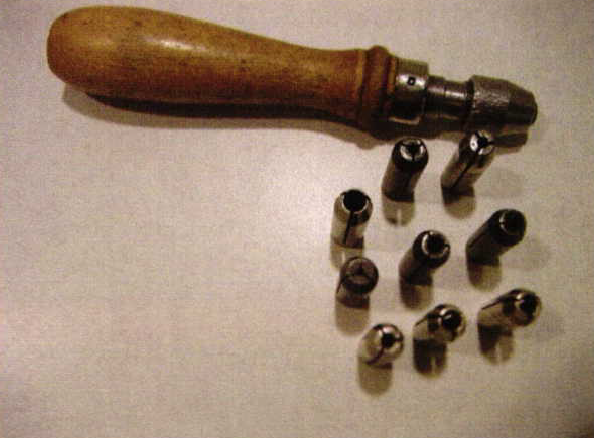Tube Setting Faceted Stones
2 Minute Read
When beginning to do tube settings, the first thing anyone should do is buy a "Setters Tube Holder" which appears in many tool supply catalogues. I have two of them for easy access.
Expose only the very top of the cullet in the tube holder. It will grip securely and will prevent the sides from collapsing while preparing the item for setting. The clamp holder has seven sizes of chucks so that you can pick the chuck that will hold the cullet securely as you worked on it. Insert your jewelry carefully and tighten very securely! Then place the diamond on top and check if there is enough metal protruding around the diamond to securely set it. If not, spread the top open with an awl.
Next start the cutting for the pavilion seat using a #156c undercutting bun that is about 112 to 314 the size of the stone size. Make a bearing low enough so that the table of the stone will be flush with the top of the bezel. Cut the bearing with slight increments of cutting so that it takes about 4-5 series of cuts to make the seat. Once this is accomplished, try to place the diamond into the hole. If it does not fit, ream out the top part of the bezel. Cut only the area from above the seat to the top of the cullet. The diamond should just fall into place inside of the hole and stay in the newly made bearing. If it still doesn't, ream it open a tad more, and use a copper stone pusher to press the stone into the seat if needed.
I usually file around the top so that I won't have so much metal to push over. I usually push the metal over the stone with a thin steel pusher that is serrated on the front end so the pusher won't slide off. Once this is started, check for any bezel spaces on the crown facet. I want all the metal over and absolutely touching the stone.
The next step is to shape the top and sides evenly. I will use a Pumice wheel, of 180 grit and I also use a triangle file #4 cut for this procedure. Then I use a right-sided onglette graver or a flat #39 and cut a bevel on the inside of the metal that is over the stone. This gives it a professional look, and it has a clean finished effect.
You assume all responsibility and risk for the use of the safety resources available on or through this web page. The International Gem Society LLC does not assume any liability for the materials, information and opinions provided on, or available through, this web page. No advice or information provided by this website shall create any warranty. Reliance on such advice, information or the content of this web page is solely at your own risk, including without limitation any safety guidelines, resources or precautions, or any other information related to safety that may be available on or through this web page. The International Gem Society LLC disclaims any liability for injury, death or damages resulting from the use thereof.
Gerry Lewy
With over 40 years experience as a stone setter, Gerry Lewy is known throughout the diamond setting community. Gerry started his 9-year apprenticeship with a jewelry manufacturer and tutored by a gentleman ‘setter’, in Haddon Gardens, London. Gerry has redeveloped himself into more than a master setter, his purpose is now to be a teacher of the art as well.
The All-In-One Jewelry Making Solution At Your Fingertips
When you join the Ganoksin community, you get the tools you need to take your work to the next level.
Trusted Jewelry Making Information & Techniques
Sign up to receive the latest articles, techniques, and inspirations with our free newsletter.
